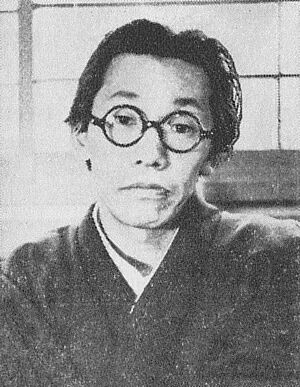Fumio Hayasaka facts for kids
Quick facts for kids
Fumio Hayasaka
|
|
|---|---|
 |
|
| Born | August 19, 1914 |
| Died | October 15, 1955 (aged 41) Setagaya, Tokyo, Japan
|
| Other names | 早坂 文雄 |
| Occupation | Composer |
Fumio Hayasaka (pronounced Hoo-mee-oh Hah-yah-sah-kah; August 19, 1914 – October 15, 1955) was a very important Japanese composer. He wrote both classical music for orchestras and amazing music for movies.
Contents
Early Life and Music
Fumio Hayasaka was born in a city called Sendai in Japan. When he was four years old, his family moved to Sapporo, a city on Japan's northern island.
Even when he was young, Hayasaka was very musical. In 1933, he and his friend Akira Ifukube started a group called the New Music League. They even held a music festival the next year!
Hayasaka won several awards for his early music pieces. For example, in 1935, his piece Futatsu no sanka e no zensōkyoku won first prize in a radio contest. Another piece, Kodai no bukyoku, won the Weingartner Prize in 1938. He also wrote music for piano and orchestra. In 1939, Hayasaka moved to Tokyo to start writing music for movies. By 1940, he was already known as a major film composer in Japan.
Film Music After the War
After World War II, Hayasaka kept writing music for films. People quickly noticed how talented he was. In 1946, he won an award for his music in the movie An Enemy of the People. The next year, he won another award for the film Actress.
In the late 1940s, Hayasaka invited his friend Akira Ifukube to join him at Toho Studios to write film music. Ifukube's first movie score for Toho was for Snow Trail in 1947. This was also where Toshirō Mifune, who became a famous actor, first met the director Akira Kurosawa.
Working with Akira Kurosawa
Fumio Hayasaka had a very special partnership with the famous Japanese director Akira Kurosawa. Their work together was amazing, but it was cut short because Hayasaka died young.
Their first movie together was Drunken Angel in 1948. Kurosawa learned a lot from working with Hayasaka. Kurosawa later said that Hayasaka taught him that movie music should be like a "counterpoint" to the images, not just background sound. This means the music should add another layer of meaning, sometimes even going against what you see on screen, to make the film more powerful.
Hayasaka wrote music for many of Kurosawa's most famous films, including:
- Stray Dog (1949)
- Rashomon (1950)
- Ikiru (1952)
- Seven Samurai (1954)
He also wrote music for films by another important Japanese director, Kenji Mizoguchi. These included Ugetsu (1953), Sansho the Bailiff (1954), and The Crucified Lovers (1954).
The 1950 film Rashomon was very important for Hayasaka. This movie won a big award at the Venice Film Festival in 1951. It was one of the first Japanese films to become famous around the world. Kurosawa had asked Hayasaka to create music that sounded like a famous Western piece called Boléro by Maurice Ravel. Another young composer, Masaru Satō, was so impressed by the music that he decided to study with Hayasaka.
In 1950, Hayasaka also started the Association of Film Music. His film Ugetsu won an award at the Venice Film Festival in 1953. The next year, his film Sansho the Bailiff also won an award at the same festival, alongside Kurosawa's Seven Samurai.
Seven Samurai was a huge movie for Japan at the time. Hayasaka's music for this film used a technique called a "leitmotif." This is when a specific musical theme is used for a character, idea, or place, like in Western operas.
Later Works and Influence
While in Tokyo, Hayasaka also wrote other important classical music pieces. These included Ancient Dances of the Left and on the Right (1941) and a Piano Concerto (1948).
Hayasaka was a mentor to other composers, including Masaru Satō and Tōru Takemitsu. He taught them a lot about music.
Death
Sadly, Fumio Hayasaka died in 1955 from tuberculosis (a serious illness) in Tokyo. He was only 41 years old. He was working on the music for the film I Live in Fear when he passed away, so Masaru Sato finished the score for him.
Kurosawa was very sad about his friend's death. The film I Live in Fear was even based on a conversation between Hayasaka and Kurosawa. Hayasaka had been very ill and was thinking about his own life and fears.
His Legacy and Influence
Fumio Hayasaka's influence continued after his death.
- Akira Ifukube, who Hayasaka encouraged to write film music, went on to compose the famous score for Godzilla. This made him well-known for music in Japanese monster movies.
- Masaru Satō, who finished Hayasaka's last score, continued to work with Kurosawa on seven more films. Sato often used Western musical styles in his scores, making them easy for people from different cultures to enjoy.
- In memory of Hayasaka, the composer Tōru Takemitsu wrote a piece called Requiem for strings in 1957.
Musical Style
Hayasaka's early music had a late-Romantic style, but it also included sounds from traditional Japanese music. Later in his life, his style became more modern. When he wrote music for films, he often used ideas and sounds from Western orchestral music to fit the movie's needs.
See also
 In Spanish: Fumio Hayasaka para niños
In Spanish: Fumio Hayasaka para niños

